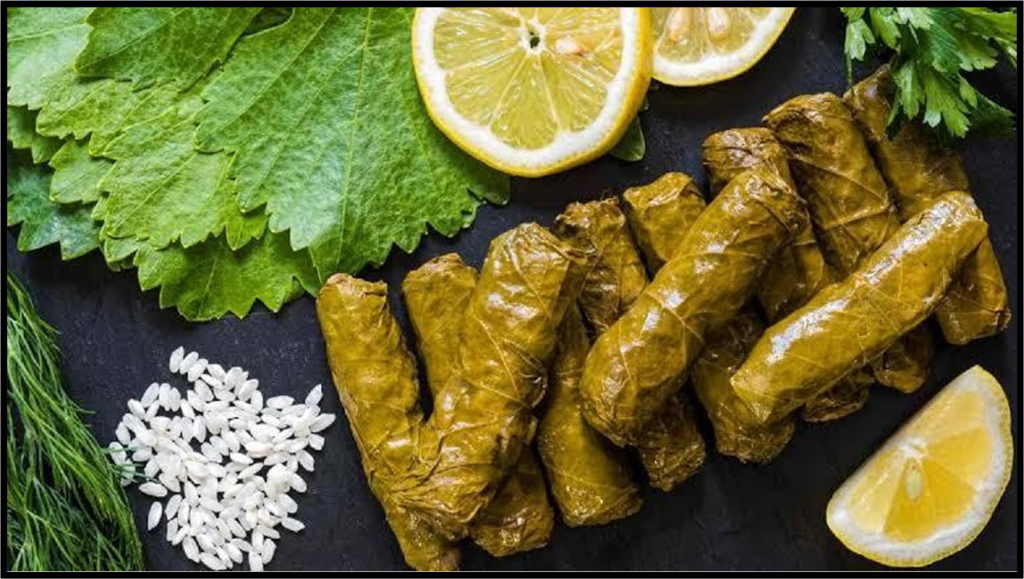When you hear “grapes,” you probably think of sweet purple or green fruits, juices, or even wine. But what if we told you the real unsung hero of the grapevine is its leaf? Yes, grape leaves—those tender, edible, heart-shaped leaves—are brimming with health benefits and are a staple in Mediterranean, Middle Eastern, and even some Indian dishes.
Let’s uncover the top reasons why grape leaves deserve a spot on your plate and how they can support everything from gut health to weight loss.

🥗 1. Low in Calories, High in Nutrition

One of the biggest draws of grape leaves is how nutrient-dense they are without being calorie-dense. A mere 5 calories per 5-leaf serving (cooked) packs in a solid dose of:
- Vitamin A (for immunity and eye health)
- Vitamin K (for blood clotting and bone health)
- Fiber (for digestion and satiety)
- Iron (for energy and oxygen transport)
- Calcium (for bones and nerve function)
If you’re on a calorie-restricted or weight-loss diet, grape leaves are a perfect add-on: flavorful, fibrous, and guilt-free.
❤ 2. A Friend to Your Heart
Grape leaves are a heart-healthy powerhouse. Here’s how:
- Antioxidants like quercetin and resveratrol (yes, the same one in red wine!) protect your heart by reducing inflammation and improving blood flow.
- Potassium helps manage blood pressure by balancing sodium levels.
- Their high fiber content can lower LDL (bad) cholesterol when eaten regularly.
💡 Fun fact: In traditional diets like the Mediterranean, grape leaves are often used in place of starchy or processed wrappers for a reason—they’re cleaner and heart-smart!
🌿 3. Rich in Antioxidants & Anti-Inflammatory Compounds

The darker and greener the leaf, the more polyphenols and plant compounds it contains. Grape leaves are no exception. These natural anti-inflammatories can:
- Neutralize free radicals
- Protect cells from premature aging
- Reduce inflammation in joints and skin
- Support liver detox and hormone balance
That’s why they’re often used in detox diets and gut-cleanse protocols.
🍽 4. Perfect Gluten-Free Wrapper & Meal Base
Ditch the bread or roti once in a while and wrap your meal in grape leaves instead. Grape leaves are:
- Gluten-free
- Vegan-friendly
- Easily rollable for stuffing with rice, lentils, paneer, or even quinoa
- Much lighter and easier to digest than tortillas or wheat-based wraps
They’re especially beneficial for those with gluten sensitivity, PCOS, thyroid issues, or bloating.
🌸 5. Supports Hormonal Balance in Women
Here’s something lesser known—grape leaves are estrogen-balancing. Thanks to their phytoestrogens and mineral content, they may:
- Ease PMS and menstrual cramps
- Support healthy periods in women with PCOS
- Improve fertility markers by reducing inflammation and aiding detox
So ladies, if you’re struggling with cycle irregularity, adding grape leaves to your diet (in moderation) might be a natural way to support your system.
🧠 6. Brain & Mood Booster

With iron, magnesium, and antioxidants, grape leaves may help with:
- Brain fog
- Low energy
- Mood swings
- Stress resilience
Their magnesium content helps calm nerves, while iron ensures enough oxygen reaches your brain. This makes grape leaves a smart pick for students, professionals, and the elderly alike.
💩 7. Improves Digestion & Fights Constipation
Thanks to their high fiber content, grape leaves:
- Add bulk to stools
- Support regular bowel movements
- Feed good gut bacteria
- Relieve mild bloating and indigestion
For those who are sedentary or have sluggish digestion, including grape leaves in 2–3 meals a week can improve gut function naturally.
Dietitian-Recommended Ways to Include Grape Leaves in Your Diet
| Dish | Description |
|---|---|
| Stuffed Grape Leaves (Dolma) | Stuff with rice, lentils, and herbs. Bake or steam with lemon water. |
| Grape Leaf Chaat | Pan-roast grape leaves, top with moong sprouts, chutney & curd. |
| Grape Leaf Wraps | Fill with grilled paneer or tofu, veggies, and tahini dressing. |
| Soups & Stews | Add chopped grape leaves to dal or sabzi for a flavor and fiber boost. |
| Detox Juice Add-On | Blend 1-2 young grape leaves with lauki, tulsi, and cucumber juice. |
A Quick Word of Caution
- Avoid if you have grape allergies
- Brined grape leaves can be high in sodium – soak in water before use
- Elderly people should chew them well to aid digestion
Final Thoughts: Small Leaf, Big Benefits
In the world of superfoods, grape leaves are truly underrated. Whether you’re aiming for better digestion, hormonal balance, or weight control, this humble leaf delivers.
So the next time you see grape leaves in the store or growing near you, don’t walk past them—wrap your wellness in them.
FAQs
Q. Can we eat raw grape leaves?
No, always cook or steam grape leaves to soften their texture and make them digestible.
Q. Are grape leaves safe during pregnancy?
Yes, when cooked properly and eaten in moderation, they’re rich in folate and iron—great for expecting mothers. Consult your doctor first.
Q. Where can I buy grape leaves in India?
Try organic food stores, gourmet sections, or order online in brined/canned form. If you have access to a vineyard, pick fresh young leaves in spring or early summer.

Hi, I’m Dietitian Dipanwita Saha, A Clinical Dietitian & Nutripreneur and The Founder & Director of Nutri World. I believe healthy eating should be enjoyable, balanced, and free from guilt—not about strict rules or cutting out your favorite foods. My passion lies in helping people heal their relationship with food, especially those dealing with disordered eating. If you’re looking for a supportive, judgment-free space to nourish your body and mind, I’m here to help—let’s make food feel good again.







